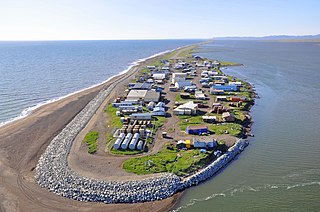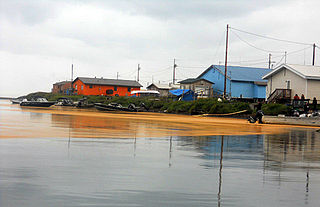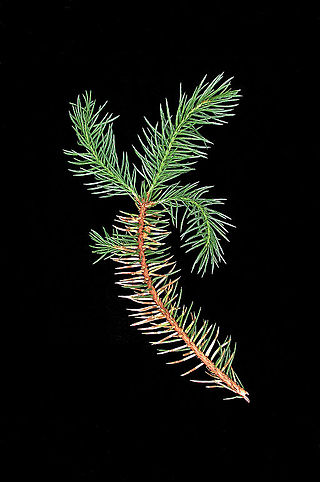
In physics, the kinetic energy of an object is the form of energy that it possesses due to its motion.

Kivalina(kiv-uh-LEE-nuh) is a city and village in Northwest Arctic Borough, Alaska, United States. The population was 377 at the 2000 census and 374 as of the 2010 census.
In linear algebra, it is often important to know which vectors have their directions unchanged by a linear transformation. An eigenvector or characteristic vector is such a vector. Thus an eigenvector of a linear transformation is scaled by a constant factor when the linear transformation is applied to it: . The corresponding eigenvalue, characteristic value, or characteristic root is the multiplying factor .
Chrysomyxa roanensis is a plant pathogen.

Chrysomyxa ledi var. rhododendri is a plant pathogen responsible for the disease spruce needle rust.
Ceropsora is a genus of rust fungus in the family Coleosporiaceae.

Chrysomyxa is a genus of rust fungi in the family Coleosporiaceae. The genus, widespread in the Northern Hemisphere, contains about 23 species. Rust fungi in the genus Chrysomyxa occur in boreal forests of the northern hemisphere on Pinaceae,, and most species alternate to angiosperm hosts in the Ericaceae.
Diaphanopellis is a genus of rust fungi in the family Coleosporiaceae. Reported as new to science in 2005, the genus is monotypic, containing the single species Diaphanopellis forrestii, found growing on Rhododendron selense subsp. selense, in the Himalayas.

Chrysomyxa ledicola is a plant pathogen responsible for the disease large-spored spruce-Labrador tea rust. It affects white spruce, black spruce, Sitka spruce, Engelmann spruce, and Labrador-tea. It is also the cause of the orange goo that covered the Iñupiat village of Kivalina, Alaska in the summer of 2011.
Chrysomyxa abietis, or spruce needle rust, is a species of rust fungi in the Coleosporiaceae family that is native to eastern Europe and northern Asia. It was introduced to Australia, New Zealand and the United States.
Chrysomyxa himalensis, is a species of rust fungi in the Coleosporiaceae family that can be found on Rhododendron and Picea species in the Himalayan region of southern Asia and was introduced in the United States.
Chrysomyxa pyrolae, is a species of rust fungi in the family Coleosporiaceae that can be found in such US states such as Alabama, Colorado, Maine and Vermont.
Chrysomyxa succinea is a species of rust fungus in the family Coleosporiaceae which was introduced to Japan where it feeds on Rhododendron dilatatum. The species were recorded from mountains such as Fuji Gotenniwa, Fuji Oniwa and the Yatsugatake Mountains.
Spruce broom rust or yellow witches' broom rust is a fungal plant disease caused by the basidiomycete fungus known as Chrysomyxa arctostaphyli. It occurs exclusively in North America, with the most concentrated outbreaks occurring in northern Arizona and southern Colorado on blue and Engelmann spruce, as well as in Alaska on black and white spruce. This disease alternates its life cycle between two hosts, with the spruce serving as the primary host and bearberry serving as the secondary or alternate host. The name for the disease comes from the distinctive “witches broom”, commonly yellow in color, which forms on the spruce after young needles have been infected. Management must be carried out through physical or mechanical methods, such as the pruning of brooms or the removal of the secondary host from the area, because no chemical control measures have yet been determined to be economically effective. Generally, spruce broom rust is seen as a mostly cosmetic issue, and it is very rarely the direct cause of tree death; however, research has shown a reduction in overall productivity and health of infected trees, making it an important issue for logging and timber companies.

Chrysomyxa weirii, is a fungus that causes a disease, commonly known as Weir's cushion rust, of spruce trees. It is mostly a cosmetic problem, causing yellowish spotting and banding on spruce needles, but in some cases can cause severe premature defoliation. Weir’s cushion rust can also disfigure and reduce growth of spruce trees by targeting the tender needles of newly emerging shoots. This pathogen's spores are spread by wind and water splash and germinate to infect newly developing needles on the same spruce, or neighboring spruce trees. Unlike many other rust disease pathogens, C. weirii is autoecious, only infecting spruce trees. C. weirii is also microcyclic, producing only two of the five possible spore stages common in rust fungi. Trees affected by Weir's cushion rust usually have obvious symptoms, but if treated correctly, the disease can be managed.

Chrysomyxa ledi is a fungus. It occurs in Eurasia throughout the range of its broad-leaved hosts. The aecial stage is found on native and exotic spruces in Europe, including white and Engelmann spruces.
Chrysomyxa nagodhii is a species of rust fungus in the family Coleosporiaceae. It was described as new to science by Canadian mycologist Patricia E. Crane in 2001. It probably occurs throughout the range of Ledum decumbens and Rhododendron groenlandicum. On Picea, spermogonia and aecia occur on distinct rusty yellow bands on current-year needles.
Chrysomyxa neoglandulosi is a fungus. It likely occurs wherever its telial host, Ledum glandulosum Nutt., is found. The only reported aecial host, Engelmann spruce, occurs in montane to subalpine areas in western Canada and the United States.
Chrysomyxa reticulata has been found on Ledum decumbens and Ledum groenlandicum in both eastern and western Canada, as well as Wisconsin, Washington, and California, in the United States, but the aecia are so far known only from artificial inoculation of white spruce.





